Focus on Physics
The Pulled Spool—Which Way Does It Roll?
The Science Teacher—April/May 2020 (Volume 87, Issue 8)
By Paul G. Hewitt
One of my favorite lecture-table demonstrations is a simple attention-grabber: gently pulling a large wooden spool by the end of a string wound around its cylindrical axle.
I don’t use the small spools used for sewing thread. For one thing, they’re too small to be seen in the back of a classroom. More importantly, they have an axle with almost the same diameter as their rims—not good. It’s necessary that the rims of the spool are appreciably larger in diameter than the axle.
Two spool orientations
Use a large spool with string wound around its cylindrical axle. The free end of the string can be pulled from the top or bottom of the axle. Simply inverting the spool changes one orientation to the other. It’s important that gentle pulls be exerted on the spool.
Pull with string on the top
When the free end of the string is on the top of the axle (Figure 1), a gentle horizontal pull to the right causes it to roll. Before pulling the string, ask your class to predict whether the spool will roll to the right toward you, or to the left away from you. Students are not surprised to see that the spool rolls toward you.
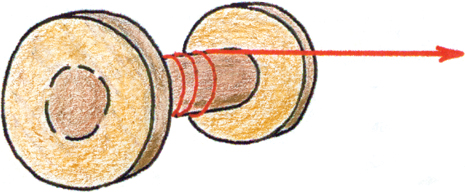
At this point you can state: “Newton’s second law of motion tells us that the change in motion of a pulled object will be in the direction of the pull. More formally, a ~ Fnet; acceleration is in the same direction as the net force that produces the acceleration.” Point out that this statement, like most physics, is common sense with structure.
Pull with string on the bottom
Invert the spool so that the string is at the bottom of the axle (Figure 2). Tell your class that you’re going to give the spool a gentle pull to the right, as before. But before you do, ask for a prediction: Will it roll to the right, as before? Or this time will it roll to the left? Your students may ponder the effect of the way the string is wound. Maybe a pull will unwind the string and the spool will roll to the left. Or maybe it depends on how hard you pull the string. Here is where wait time is very important.
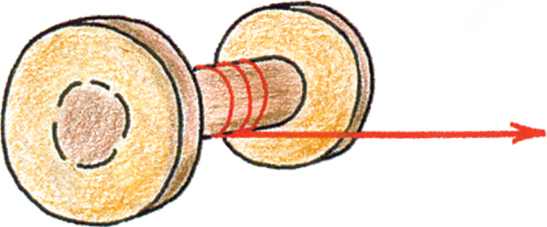
Check your neighbor
Wait time should be a check-your-neighbor routine. Reiterate what you said before: The change in the spool’s motion (at rest before the pull) will be in the same direction as the pull that produces it. Anybody wish to change their mind? There’s some suspense—before you pull the string. As before, the spool rolls to the right—in the direction of your pull. For some, this is surprising.
Explanation time
In both cases the spool rolls in the direction of the pull—toward the right. After the excitement of seeing the spool rolling to the right, and with the interest of the class piqued, it’s time for your detailed explanation. Begin by placing the spool at rest. Ask how many forces are acting on it. Your students may say “zero,” at which point you ask about vertical forces.
Vertical Forces
Distinguish between individual forces and net force. Although the net force on the spool is zero before the pull, in accord with the equilibrium rule, ∑F = 0, sketch two familiar vertical forces, which your class can suggest (Figure 3, left). There’s the downward pull of gravity, mg, and the upward support of the table, the normal force, N. Ask how the magnitudes of this pair of forces compare. As evidenced by the rest position, both mg and N must be equal and opposite. They cancel. The spool undergoes no change in motion vertically.
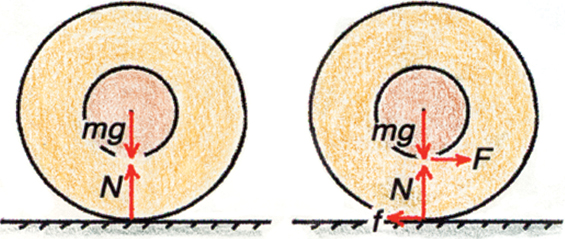
Left: Forces on the spool at rest. Right: Forces on the spool when pulled.
Horizontal forces
Next, ask what horizontal forces act while the spool is at rest. Again, the answer is none, as no change in motion occurs horizontally. Ask if a force of friction is acting on the spool at rest. This may elicit some class discussion, after which all agree that friction is zero—for the time being. Friction won’t occur until the spool is tugged. So when the spool is pulled horizontally there are two horizontal forces that act on the spool; the pull F to the right, and friction f to the left, which you sketch (Figure 3, right). At this point you can tell your class there is always, in physics, more than first meets the eye. That “more” in this case is rotational motion.
Torque and Rotation
Motion of the spool across the lecture table is more than translational. Clearly, the spool also rotates. Whereas we speak of forces for sliding objects that don’t rotate, we speak of torques for objects that do rotate. A torque is sort of a twisting tendency that changes rotational motion; it involves force and a particular distance between the line of force and the axis of rotation. We call this distance that can produce leverage the lever arm. The amount of torque is defined by the product of the two: Torque τ = lever-arm × force (Figure 4).
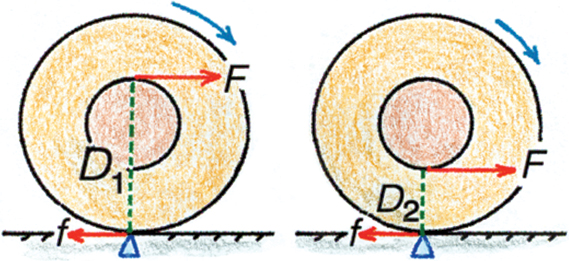
Both torques produce clockwise rotations.
Clockwise rotation
Pulling the string tends to topple the spool about its point of contact with the table, which is the point about which the spool rotates when it starts to roll. Specifically, the string pull F multiplied by the lever arm D is the torque τ that produces rotational motion of the spool. Can you see that the force exerted on the left-hand spool in Figure 4 has considerably greater leverage due to the longer lever arm (shown by the green dashed line)? And, for the same amount of pull, does this produce a greater torque on the left-hand spool than on the right-hand spool? Yes to both questions, because the lever arm distance for the left spool, D1, is longer than that for the right spool, D2. That’s why it takes a smaller tug on the left-hand spool than on the right-hand spool to get the rotation started.
Friction
No friction acts on the spool while it is at rest, but when the string is pulled, a force emerges that tends to prevent motion. This is static friction. When the force of the pull is sufficient, the spool begins to roll. Once rolling, static friction is replaced by rolling friction. If the spool were to slide rather than roll, the friction would be kinetic friction. The force of kinetic friction is less than the maximum that can be reached by static friction, and rolling friction is even weaker than static friction. That’s why it’s easier to keep something moving than to start it moving, and why it’s easier to roll on wheels than to slide.
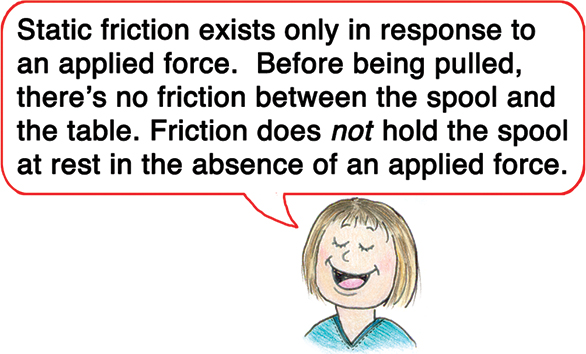
The value of predictions
What makes this demonstration a learning experience is the predictions it elicits. Predictions by students, explanations in check-your-neighbor fashion, with some time before you present your explanations, is the mark of an effective physics class. Greater than entertainment is student satisfaction in “getting it.” What students should enjoy most in your class is the appreciation of your step-by-step explanation that consolidates their own discussions. A teacher too anxious to provide explanations without first asking students to do so is likely new to teaching. Seasoned teachers nurture student thinking before displaying their own.
Pulling at an angle
Ask your students to predict the outcome of pulling the free end of the string about the axle straight up. After discussion, you can show that the upward tug on the string exerts a counterclockwise torque about the contact point. Aha, the spool rolls to the left!
Critical angle
Show how an upward pull of the string at a particular angle will produce rest or some sliding rather than a roll of the spool. This occurs when the line of action of the pull passes directly through the point of spool contact with the table. At this angular position there’s no lever arm—which means no torque. The angle of pull for this case is called the critical angle (Figure 5). It depends on the relative axle and rim diameters of the spool. The spool can remain at rest at this position because the force of friction and the horizontal component of your pull are equal and opposite. Horizontal net force is zero (as is vertical net force). The spool remains at rest.
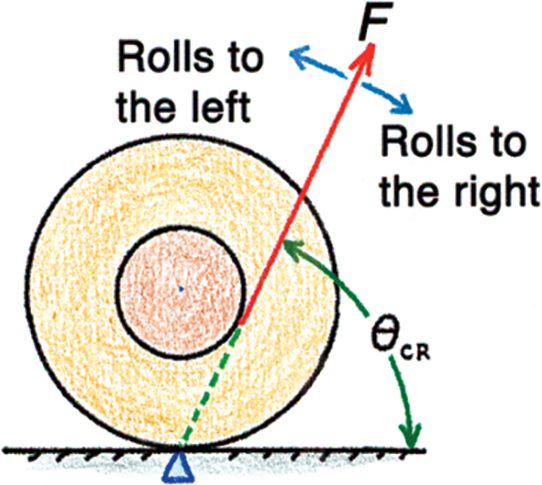
A pull at the critical angle.
A pull of the string at an angle greater than the critical angle will produce a counterclockwise rotation of the spool; it rolls to the left. A pull at an angle less than the critical angle will produce a clockwise rotation of the spool; it rolls to the right. At the critical angle a harder pull may produce sliding. Showing and explaining these pulls can be a solid educational experience—and a fun one. Enjoy good physics!
Paul G. Hewitt (pghewitt@aol.com) is the author of Conceptual Physics, 12th edition; Conceptual Physical Science, 6th edition, coauthored with daughter Leslie Hewitt and nephew John Suchocki; and Conceptual Integrated Science, new 3rd edition, with coauthors Suzanne Lyons, John Suchocki, and Jennifer Yeh.
Physical Science Physics High School


